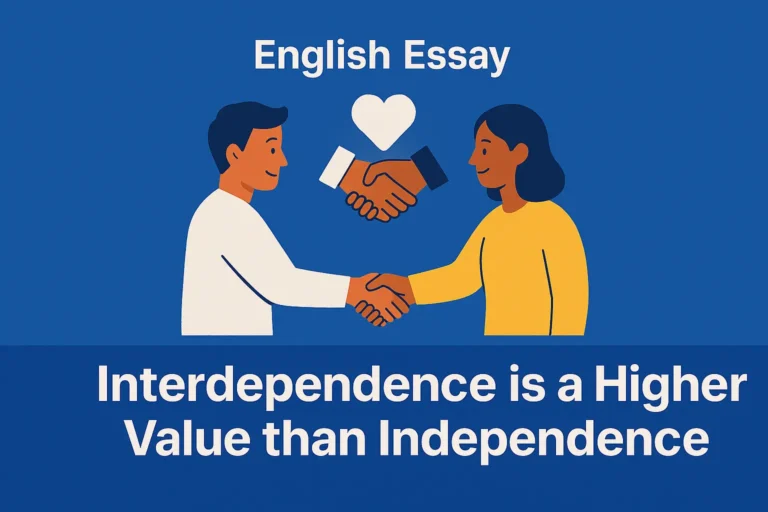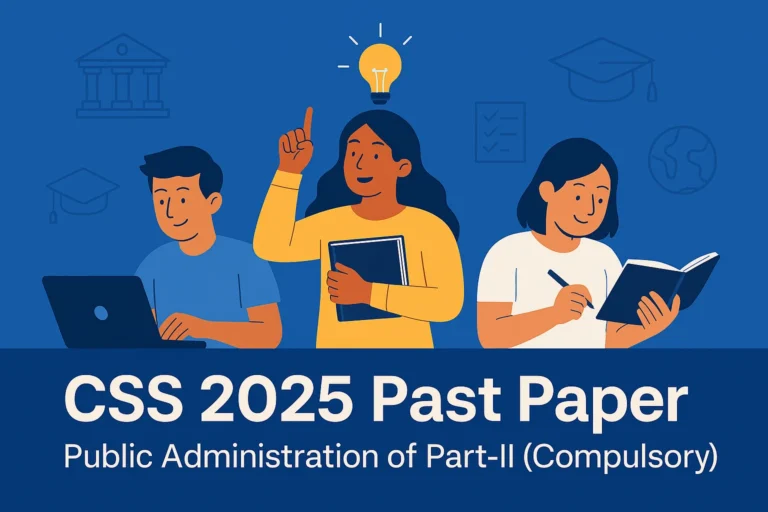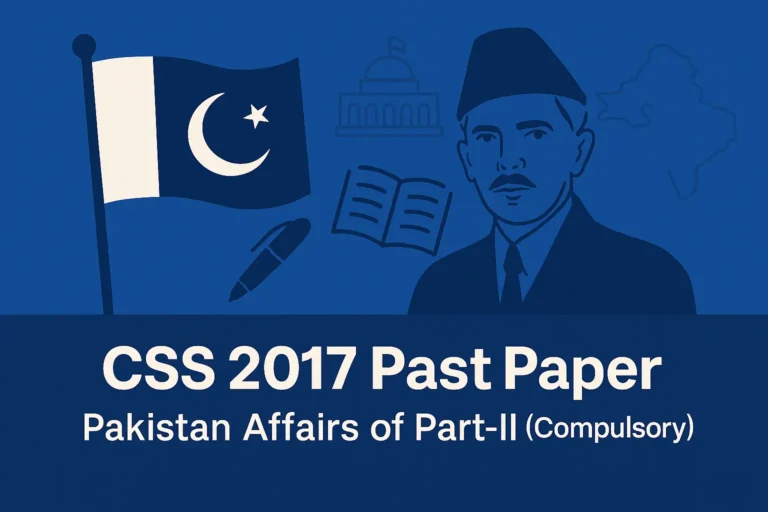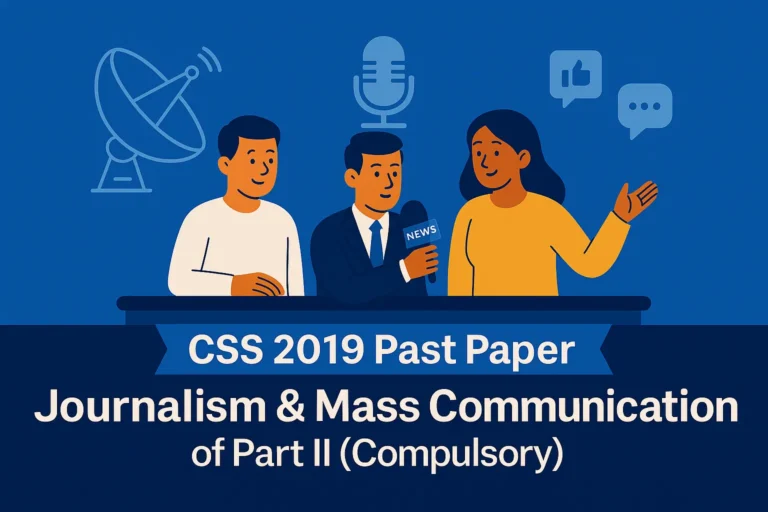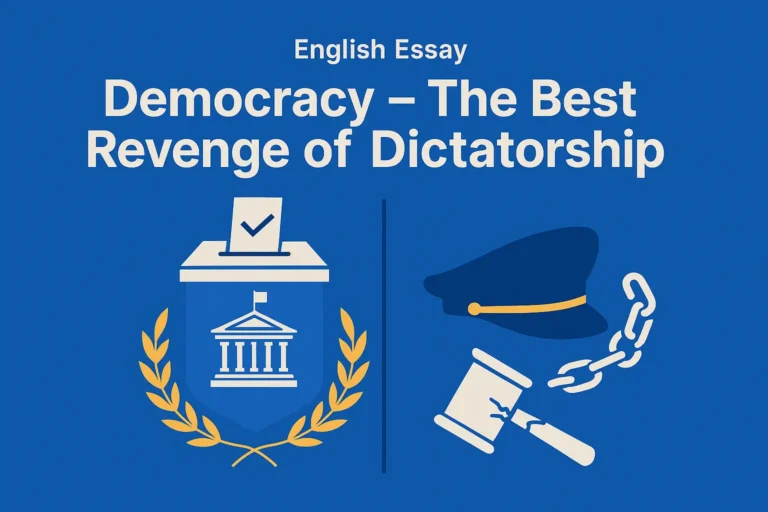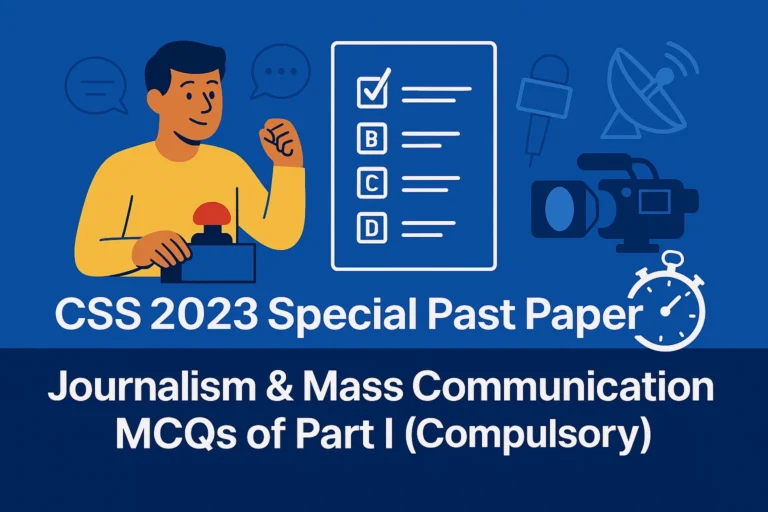CSS Past Paper 2025 Agriculture and Forestry MCQs (Part 1)
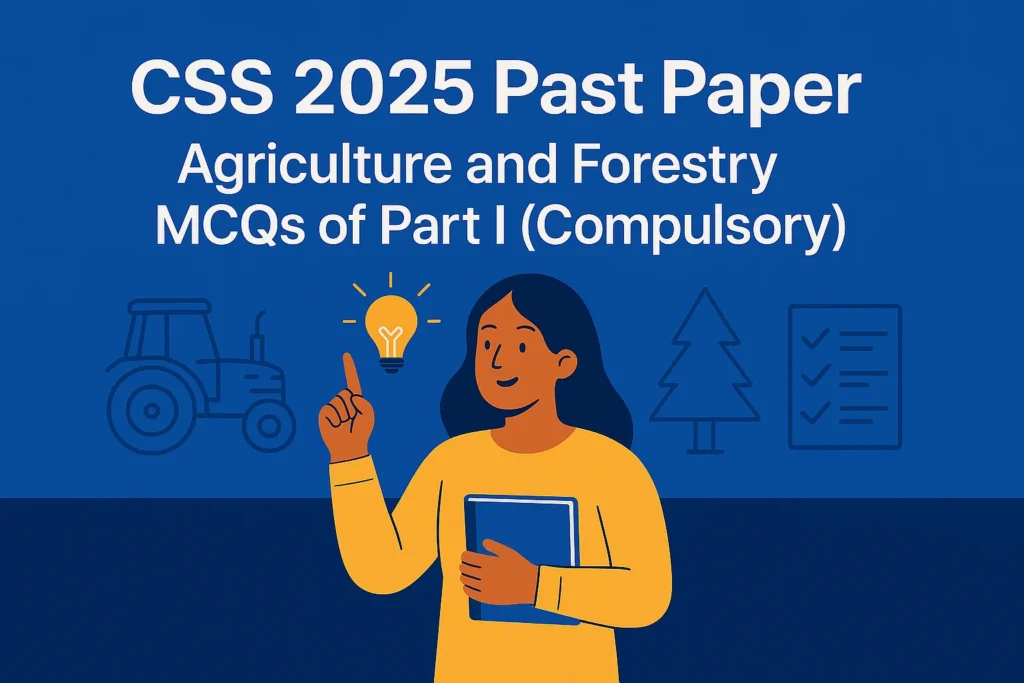
CSS | Past Paper | Group | 2025 | Part 1 | MCQs
Below are the solved multiple-choice questions (MCQs) from the CSS Past Paper 2025 Agriculture and Forestry MCQs (Part 1). Each question includes all the options, the correct answer is bolded, and a short explanation is provided for clarity.
1. Neem tree is used for:
(A) Timber
(B) Fuel
(C) Fodder
(D) Medicine
💡 Neem has strong medicinal properties and is widely used in traditional medicine.
2. The solar radiation that bounces back in the atmosphere is mostly:
(A) Gamma rays
(B) Alpha rays
(C) X-rays
(D) Infrared rays
💡 The Earth re-emits absorbed solar energy mainly as infrared radiation.
3. A structure for diverting the flow of water in a river is called:
(A) Dyke
(B) Gully plug
(C) Dam
(D) Sunken dam
💡 Dams divert, store, and regulate river water flow.
4. Range area refers to a large semi-arid area having vegetation suitable for:
(A) Fuel
(B) Grazing
(C) Shelter
(D) Shade
💡 Rangelands are natural grazing areas for livestock.
5. National Climate Change Policy was prepared in:
(A) 2010
(B) 2012
(C) 2013
(D) None of these
💡 Pakistan announced its National Climate Change Policy in 2012.
6. Genome D of wheat is most probably contributed by:
(A) T. aestivum
(B) T. aegilops
(C) T. tauschii
(D) Secale cereal
💡 The D genome of wheat originated from Triticum tauschii.
7. Crossing of a hybrid individual with any one of its parents is called:
(A) Back cross
(B) Top cross
(C) Test cross
(D) Multiple cross
💡 Backcrossing introduces desirable traits by crossing hybrid with parent.
8. Inbreeding leads towards depression in productivity in:
(A) Self-pollinated crops
(B) Cross-pollinated crops
(C) Vegetatively propagated crops
(D) None of these
💡 Cross-pollinated crops show reduced vigor under inbreeding (inbreeding depression).
9. In gel electrophoresis DNA is separated on the basis of:
(A) Charge
(B) Size
(C) Random movement
(D) None of these
💡 Smaller DNA fragments move faster, so separation is based on size.
10. Crop plants which protect the soil surface from erosion are called:
(A) Nurse crops
(B) Cover crops
(C) Trap crops
(D) Relay crops
💡 Cover crops reduce erosion by protecting soil surface.
11. Country that leads as highest in wheat productivity in the world is:
(A) Pakistan
(B) India
(C) China
(D) United States
💡 The U.S. leads in wheat productivity globally.
12. In 1992-93 the great decline in cotton production was due to the attack of:
(A) American Bollworm
(B) Pink Bollworm
(C) Cotton leaf curl virus
(D) Spotted Bollworm
💡 Cotton leaf curl virus outbreak caused a major production drop in Pakistan.
13. Raising of only one crop in a year when there is a seasonal supply of water is called:
(A) Mono-cropping
(B) Monoculture
(C) Specialized farming
(D) None of these
💡 Mono-cropping means growing one crop type during the season.
14. Nipping in chickpea is a practice used to:
(A) Protect from lodging
(B) Reduce height
(C) Enlarge branching
(D) All of these
💡 Nipping in chickpea reduces height, prevents lodging, and increases branching.
15. As per principles of crop rotation pulses should be included in rotation to:
(A) Increase pulses production
(B) Increase yield of succeeding crop
(C) Help in improving soil fertility
(D) Improving profitability of farmers
💡 Pulses fix nitrogen, improving soil fertility and benefiting next crops.
16. Nitrogen is absorbed by plant roots in the form of:
(A) NO₃
(B) NO₂
(C) N₂O
(D) N₂O₂
💡 Plants mainly take up nitrogen as nitrate (NO₃⁻).
17. Conversion of organic form of an element into an inorganic form is termed as:
(A) Mineralization
(B) Immobilization
(C) Nitrification
(D) Denitrification
💡 Mineralization releases nutrients in inorganic forms available to plants.
18. About 80% of the phosphorus transported from soil to root surface is through:
(A) Diffusion
(B) Root interception
(C) Mass flow
(D) Bulk flow
💡 Phosphorus is mainly transported to roots via diffusion in soil.
19. Which of following is not an essential plant nutrient?
(A) Molybdenum
(B) Copper
(C) Chloride
(D) Cadmium
💡 Cadmium is toxic, not an essential nutrient for plants.
20. Sex nucleus which fuses with another in sexual reproduction is known as:
(A) Cell
(B) Seed
(C) Spore
(D) Gamete
💡 Gametes fuse during fertilization in sexual reproduction.
📘 Benefits of Practicing These MCQs
- ✅ These CSS Past Paper 2025 Agriculture and Forestry MCQs are compiled from authentic FPSC CSS past papers to match the real exam format.
- 💬 Practicing this CSS Past Paper 2025 Agriculture and Forestry MCQs set builds strong conceptual clarity for upcoming CSS exams.
- 🧾 Every question in this CSS Past Paper 2025 Agriculture and Forestry MCQs collection follows the official CSS exam syllabus approved by FPSC.
- 📊 Students appearing in CSS 2025 can rely on these Agriculture and Forestry MCQs for focused and authentic revision.
- 🔍 The solved CSS Past Paper 2025 Agriculture and Forestry MCQs section includes clear, one-line explanations for quick understanding.
- 🎯 Revise these CSS Past Paper 2025 Agriculture and Forestry MCQs regularly to master key topics from the CSS exam syllabus and boost your score.
- 🏆 These CSS Past Paper 2025 Agriculture and Forestry MCQs are essential for mastering the FPSC exam pattern and achieving success in CSS.
🏁 Final Note
Keep revising these CSS Past Paper 2025 Agriculture and Forestry MCQs to strengthen your grip on important concepts and improve accuracy in upcoming CSS exams. Regular practice with these CSS Past Paper 2025 Agriculture and Forestry MCQs will help you score higher and build full command over the CSS exam syllabus.
👉 Also read CSS Past Paper 2025 Agriculture and Forestry (Part-II Descriptive)
🔗 Check FPSC past papers directly from the official FPSC website.

